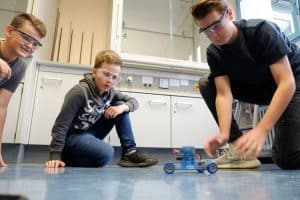New class on hydrogen at German secondary school
From where will we get our electricity in the future? What will we use to power our cars and trains? How can we live sustainably, without the use of fossil fuels? Finding answers to these and other questions is the aim of an Erasmus+ project involving students and teachers at Heriburg-Gymnasium, a German secondary school in the state of North Rhine-Westphalia, as well as British, Greek and Spanish partner organizations. The project is led by Ariema Energía y Medioambiente, a spin-off from Spain’s National Institute for Aerospace Technology. British partner Cyber Coach Smart is developing a digital learning game.
The three-year endeavor, called CIRO, consists of multiple phases. Phase 1 led to the development of new, partly interactive teaching materials on energy generation and climate change. In a one-week meeting at Greek partner institute Center for Renewable Energy Sources, the teachers from the participating schools in Spain and Germany agreed to create five modules for the CIRO project. They then gathered and sketched out ideas for experiments as well as class projects and published them on Moodle. The modules are:
1. Climate change and sustainability
2. Renewable energies
3. Energy storage
4. Integrating hydrogen into clean energy systems
5. Hydrogen applications
These modules will now be completed in the second phase, extended because of the Covid-19 virus outbreak. At Heriburg-Gymnasium, this meant adding an optional course to the mandatory curriculum. The current CIRO class, made up of eleven 8th graders, spends three hours a week working in the chemical lab under the supervision of Christine Uphues, the school’s chemistry and English teacher.
With the help of digital measuring tools and carbon dioxide sensors, the students initially conducted combustion experiments to gain a deeper understanding of the anthropogenic greenhouse effect. These experiments were followed by research on renewable energy to impart basic knowledge of green hydrogen storage requirements. The school also bought a large number of fuel cell toy cars to demonstrate to the class how the technology works. In January, at open house, a large solar panel then powered a Hofmann’s voltameter despite rather gray weather. On the same day, oxyhydrogen samples illustrated to the younger and older guests how much energy hydrogen contains, while the in-house 3D printer was used to create a model of a fuel cell’s inner workings.
The students also visited Wuppertal‘s Bergische Universität, examining microbial and enzymatic fuel cells in the university’s school student lab in an effort to broaden their knowledge of fuel cells. A trip to Mülheim-based Max Planck Institute, which was scheduled for later this year, would have given them an opportunity to gain deeper insights into hydrogen storage technology. But that visit had to be postponed because of the pandemic.
The main language used in Heriburg‘s CIRO class is English so students can communicate with their partner school peers and come prepared for the third phase of the project. This way, the course is not only a sensible addition to Heriburg’s bilingual European School curriculum but also offers students a glimpse into the world of science, where English is the de facto standard. Additionally, it helps them see that speaking another language is not as hard as they may think, even if giving a presentation in a foreign language can seem quite challenging to a 14-year-old with a bad case of the jitters.
…
Enjoy reading more in the latest edition of the H2-international October 2020
Autorin: Christine Uphues, deputy school management of the Heriburg-Gymnasium in Coesfeld

























0 Comments